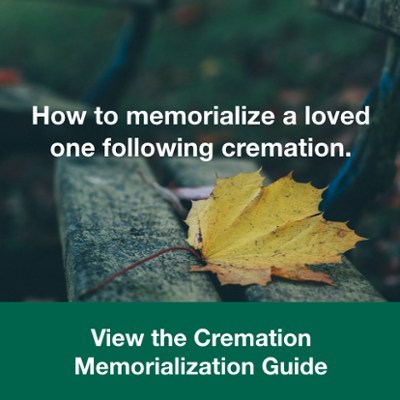Cremation is on the rise in the U.S. In fact, by 2040, the National Funeral Directors Association (NFDA) predicts that 78% of all final dispositions will be cremations.
As this trend continues, the NFDA report suggests that, “Many consumers are still unaware of the full spectrum of choices available for end-of-life services.”
Our memorial specialists often hear the same thing, as most families are unsure of the options that come with cremation: How much will it cost? Can an urn be buried? Does cremation limit memorialization options?
In response to changing consumer preferences, it’s important for families to know what is and isn’t true about the general process, costs and services associated with cremation.
To help you understand your options better, we debunk common cremation myths below.
1. Myth: Cremation is Cheaper Than Burial
Many people believe that the overall cost of cremation is cheaper than burial, but the truth is, the costs are comparable when configuring the products and services selected.
The NFDA suggests the average cost of a funeral with a viewing and burial in 2019 was $7,640, compared to $6,645 for a funeral with a viewing and a cremation casket and urn.
Some factors that may influence the final dollar amount of a cremation include:
- Transfer of the deceased.
- Services of licensed professional and staff.
- Care of the deceased (embalming, refrigeration).
- Selected services (visitation, wake, funeral, gathering, memorial).
- Container (urn, casket, vault, grave liner).
- Service personalization (music, flowers, candles, cards).
- Final resting place (plot, columbarium, mausoleum).
Therefore, it’s hard to deem cremation cheaper than burial and vice versa. After all, the price of any final arrangements comes down to your family's personal budget.
2. Myth: Cremation Limits Memorialization Options
Contrary to popular belief, cremation does not limit the ability to memorialize the deceased. You can honor and celebrate a cremated loved one in the same way someone who was buried can.
There are three general cremation memorialization options:
- The remains can be buried or placed in a permanent location. It can be in a burial plot, placed into the granite of a memorial or bench, put in a columbarium, or be part of a cremation garden.
- The remains can be placed in a cremation urn at home. Options include decorative urns—which are made out of wood, stone, or something else—or memorial jewelry—such as charms, bracelets, or other forms of jewelry that hold ashes and/or symbolize the individual.
- The cremated remains can be scattered in a meaningful location. Some choose to scatter the remains by air, others choose somewhere on land, and pick to do it over a body of water.
If you choose to memorialize the cremated remains in a permanent resting place, there are a nearly infinite number of personalization options, including:
- Memorial size and shape.
- Memorial material.
- Personalization options, such as inscriptions, images, photos, sculptures, carvings and vases.
When choosing an urn to hold the remains, you'll want to consider the following:
- Urn material.
- Urn size.
- Urn personalization options.
- Urn pricing.
As you can see, with cremation, there is nearly no limit to how you can honor and celebrate the individual.
>>> To learn more about the extensive options available for honoring and celebrated a loved one who chooses cremation, take a look at The Comprehensive Guide to Cremation Memorialization.
3. Myth: Cremation Restricts Service Options
Many people believe that you can’t have a funeral with cremation, but that’s simply not the case.
Cremation offers the same options as burial. The only difference is that these services may occur before or after the cremation, and may or may not have the body or cremains present.
Some common cremation services include:
- Wake. A wake is a public event for friends and family members to gather. The body is present at this time for people to view and offer condolences to loved ones of the deceased.
- Funeral. A funeral is a private ceremony that takes place before the deceased’s body is buried or cremated. Similarly to a visitation, the body is present during this time, but the family may choose to keep the casket open or closed. A funeral is typically held at a church or funeral home.
- Memorial Service. A memorial service is a ceremony that takes place after the deceased’s body is buried or cremated. In the event the body was cremated, the cremains are displayed in an urn with friends and family present. Memorial services may be held at a funeral home, church or other place of significance to the deceased.
- Gathering. A gathering takes place after a funeral or memorial service, and gives close friends and family members time to spend together and remember the life lost. The body is typically not present at this time. Since gatherings are more casual, friends and family may congregate at a restaurant, park, home, event space or social hall.
When you choose cremation, there are many options for commemorating a loved one.
Are you looking for a unique and meaningful way to memorialize your loved one’s cremated remains? Contact us today to learn about the many cremation memorials and monuments we offer.
Read the Guide on Cremation Memorialization
Our comprehensive guide walks you through the cremation memorialization options available for honoring and celebrating a loved one.
Editor's note: This blog post was originally published in 2018. We updated it in November 2020 to be more comprehensive and current.




